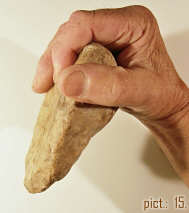TACHOVIEN
Tachovien – new prehistoric discovery locality by the town Tachov in the west of the Czech Republic
In the small area of gentle slope near
peripheral part of the town Tachov almost 2000 prehistoric stone
tools were withdrawn by the surface collection during the years
2012-2015.
There are predominantly stone lacerate tools, stone scrapers and
stone cutters. The discovery of the special stone implements of
different shapes and sizes is also numerous. Blunt stone crushers
prevail, but there are also sharp forming stone shoppers and stone
tools for shedding the bark of trees. So we have a deal with highly
specific stone tools.
Forming of the initial stone materials is not based on the core of
the minerals, but the technology of nips was used. However the
shaping is very rough and unsightly, although it meets the ergonomic
requirements for the ideal hold of its prehistoric user. The great
variability in size of the tools is also very obvious.
The majority of the stone tools is middle-sized, but there is a
great number of tools which are extremely big or on the other hand
the tools which are miniature.
Only one half of the tools is shaped for the right hand. One third
of the inventory served solely to left-handed people. More
flawlessly shaped tools were intended for grasp with the left as
well as the right hand. The most commonly used materials for the
production of the stone tools were various kinds of silica minerals.
Local quartz of hydrothermal origin was used to make three quarters
out of the total number of the tools in the Tachovian collection
evaluated so far.
It was quartz which was used predominantly to make stone lacerate
tools and stone scrapers. The stone cutters were made by knipping of
the local mineral amphibolit. One of the favourite minerals for
making the stone implements was apart from silicits also quartzrock.
There are also imported minerals in the collection such as
versatile flint extremely tough flintrock and pegmatite. Very unique
are also tools made from breccia and eucarite.
There are about 15 different kinds of minerals specified by the
experienced geologist which were used to make the stone tools found
in Tachov discovery locality.
According to the level of knapping and in some cases even percussion
reduction, the way of retouching of the working surface of stone
implement parts as well as the imperfect look of the prehistory
products we can rank these artefacts to early young paleolithic
period most likely the Aurignacian era or the late Gravettian era.
This temporary estimation must be verified by further research.
Usefulness and flawlessness of the ergonomics of the tools is also
noteworthy. Aesthetics of the visual aspect of the prehistoric stone
tools was not considered to be prime for their originators. Thier
functionality was important. The level of roughwork of the handhold
is considerably different, too. Also the wearing of the working part
of the tools differs. And thus the tools could have been made and
used for work at this location for a relatively long period of time.
Presumably within the period of many centuries even thousands of
years.
But one fact is for sure. The tools discovered in this location were
used by prehistoric inhabitants to process plant and animal
products.
Considering the ammount of the prehistory products found in this
area and their specific features which can not be compared with any
other surrounding paleolithic areas, the name Tachovien was chosen
to designate this location. The name chosen for the newly discovered
prehistoric culture located by the banks of the river Mže evokes
situating the discovery locality to the immediate neighbourhood of
town Tachov.
The area by the banks of the river Mže used to be inhabited by
quite numerous prehistoric community of hunters as well as people
who processed the caught animals. In the prehistoric processing
center where animals were transported by the river Mže they were
able to flay and carve them professionally and further on they could
also work them perfectly in a very high professional level. Not only
could they tan the skin by tannedthrough but perhaps maybe the
prehistoric people also made clothes out of the processed material.
The stone implement for decoration use found in the location was
used for the printing of the surface of clothes by stamping and it
is the evidence of the first clothing design.
The stone crushers show marks of work with tough matrials not only
of bone crushing but also of plant substances. It was predominantly
the bark of the trees used to gain tan waste. If the further
research proved that the prehistoric people were truly familar with
the technology of fur processing by the method of tanning it would
mean the essential progress in our knowledge about the cultural and
technological development of the prehistoric inhabitants of the west
Czech basin area.
It is not yet unequivocally possible to state taking into account
the discoveries obtained so far, whether there were neandertal
people, or yet they were modern cromagnon type of people who lived
and worked in the area by the banks of the river Mže next to the
present day town Tachov in the west of the Czech republic twenty or
thirty thousand years ago.
However, the already found stone tools unambiguously give evidence
about the extraordinary abilities which helped people in that period
to survive in rough natural conditions of the Palaeolithic period.
Author: MVDr. Pavel Kroupa
Český les, 2015.
